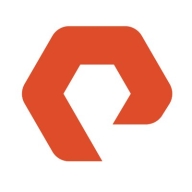


Dell ObjectScale and NetApp StorageGRID are major players in the storage solutions market. Dell ObjectScale has an advantage with its robust integration capabilities and scalability.
Features: Dell ObjectScale integrates seamlessly with other Dell products like PowerScale, ensuring a comprehensive ecosystem. Its S3 protocol implementation and stable scalability make it suitable for managing large-scale data efficiently. The efficient data management and API integration further add value. NetApp StorageGRID is notable for its data deduplication and compression, which significantly enhance storage efficiency and speed. It supports strong Information Lifecycle Management (ILM), providing flexibility in configuring data durability and protection. The user-friendly interface and ease of manageability are valuable features appreciated by users.
Room for Improvement: Dell ObjectScale could improve third-party integration and customer support, particularly in Taiwan. It also needs performance enhancements and advanced disaster recovery features. NetApp StorageGRID should enhance metadata storage efficiency and its user interface. Moreover, it could benefit from improved integration with third-party monitoring systems and more versatile configuration options.
Ease of Deployment and Customer Service: Dell ObjectScale offers integrated on-premises solutions, though support quality varies by region, especially after the Dell and EMC merger. Users notice challenges in support due to integration issues. NetApp StorageGRID provides flexible deployment options for private and public clouds, yet its customer support could improve in terms of proactive problem-solving and comprehensive guidance during complex scenarios. Both are recognized for proactive technical teams in specific regions, but NetApp could benefit from better monitoring platform integration.
Pricing and ROI: Dell ObjectScale, though expensive initially, offers cost-effectiveness in scalability and long-term data management, providing good ROI with its stability and reliability. NetApp StorageGRID's high pricing can be off-putting but is justified by its scalability for large-scale storage needs, presenting a favorable ROI when fully integrated within enterprise environments.
It does not require much management once you set up correctly, so it saves time, allowing an admin to focus on other work.
I have seen both time savings and cost savings, so there is definitely a return on investment with Dell ECS, along with peace of mind.
I would rate them an eight out of ten.
The support is done through email and is not that great, making it a very problematic area I've been dealing with for over four years.
There is a lack of SUSE Linux experts which affects the level of support.
The response time and quality of the technical support are satisfactory.
Customer support is generally good but sometimes struggles with complex issues.
When evaluating the technical support of NetApp StorageGRID, I would give it an eight out of ten.
I would rate the support for NetApp StorageGRID as eight out of 10.
That's due to the fact that we haven't implemented all the technical support facilities in NetApp.
Pure Storage FlashBlade is scalable.
Through the fabrics, it provides the clustering, allowing us to add nodes easily.
It allows scale-out processes by adding extra nodes, providing flexibility for customers to increase capacity on demand.
I would rate scalability between eight or nine, as it provides a good ability to scale and expand storage.
The scalability of NetApp StorageGRID has been proven as we've expanded twice.
The scalability of NetApp StorageGRID rates an eight or nine out of ten.
In case there is any issue with any blade, the data is moved to another.
We have not experienced any outages in the last four years.
We use it in very critical areas inside Saudi Arabia with critical customers.
I'd rate stability maybe 9.5 out of ten.
My impression of the stability of NetApp StorageGRID is quite high; from one to ten, I would rate it a nine.
We experienced very little stability issues.
Technical support definitely needs significant improvement.
Its configuration should be easier.
Live logs should be viewable through the GUI like with Logstash or Elasticsearch.
The deployment is not easy, and some expertise is required to configure the virtual data center and replication groups.
Incorporating extra integrations beyond S3, like Hadoop file systems, and being well aligned with trends like AI solutions would be beneficial.
They need to focus on a better upgrade path with easier and more resilient upgrades.
It would be great if it could fix internal issues itself without manual intervention.
In terms of functionality, reliability, and scalability, we are satisfied with NetApp.
The pricing of Pure Storage FlashBlade is expensive compared to other products I used from other companies in the past, but one benefit is that they have built-in ransomware protection.
It relies on nearline SAS drives, which are cheaper than flash or SSDs.
The pricing model is on the higher side compared to other vendors.
The price is reasonable given the abundance of features, including managing, control, host resources, dockers, and containers.
I'd rate the pricing eight out of ten.
It would definitely be more on the expensive side, especially if you compare it with open source solutions like Ceph.
From what I understood, it was cheaper than EMC ECS, though this was over seven years ago.
We can plug in many blades, and we can have data up to one terabyte.
The best features of Pure Storage FlashBlade include better throughput and better performance.
The stability of this solution is a major advantage, as we've not experienced any outages in the last four years.
Dell ECS helps with managing storage requirements since it's S3 kind of object storage with all needed enterprise features such as immutability, snapshotting, and application management, which are nice sets of features usually required.
The impact of Dell ECS on my organization has been positive, improving user experience, security, and reliability.
The feature of NetApp StorageGRID that has significantly improved data storage management for my customers is the value of the S3 API because it allows developers who are not infrastructure-oriented to use it and write code against it.
NetApp StorageGRID is a great alternative to AWS S3 buckets.
The scalability is very effective for our customers.
| Product | Market Share (%) |
|---|---|
| Dell ObjectScale | 7.3% |
| Pure Storage FlashBlade | 5.7% |
| NetApp StorageGRID | 5.8% |
| Other | 81.2% |



| Company Size | Count |
|---|---|
| Small Business | 11 |
| Midsize Enterprise | 11 |
| Large Enterprise | 20 |
| Company Size | Count |
|---|---|
| Small Business | 12 |
| Midsize Enterprise | 12 |
| Large Enterprise | 11 |
| Company Size | Count |
|---|---|
| Small Business | 5 |
| Midsize Enterprise | 4 |
| Large Enterprise | 11 |
FlashBlade is the industry’s most advanced scale-out storage for unstructured data, powered by a modern, massively parallel architecture to consolidate complex data silos (like backup appliances and data lakes) and accelerate tomorrow’s discoveries and insights.
Dell ObjectScale is a next-generation S3 object storage platform known for scalability, performance, and efficiency. It integrates with Dell EMC products, combining hardware and software for seamless user experience in the AI era.
Dell ObjectScale implements the S3 protocol, integrating smoothly with Dell EMC solutions like ISILON. Its architecture supports data compression and interoperates with multiple protocols for enhanced performance. Enterprise features include immutability, geo-replication, and user-friendly management. However, it needs better integration with other systems, enhanced security, and disaster recovery. Write performance and scalability improvements, competitive pricing, and documentation enhancements are key areas for progress. The interface could be more straightforward, with more remote management features and native analytics.
What features does Dell ObjectScale offer?Industries leverage Dell ObjectScale for cloud-based object storage, archiving, and backups. It's favored for unstructured data management, CCTV integration, and document archiving. Strong in data analytics, it integrates well with high-capacity applications, enhancing data retention strategies across fields.
Store and manage unstructured data at scale using NetApp StorageGRID for secure, durable object storage. Place content in the right location, at the right time, and on the right storage tier, optimizing workflows and reducing overall costs for globally distributed rich media.
We monitor all File and Object Storage reviews to prevent fraudulent reviews and keep review quality high. We do not post reviews by company employees or direct competitors. We validate each review for authenticity via cross-reference with LinkedIn, and personal follow-up with the reviewer when necessary.